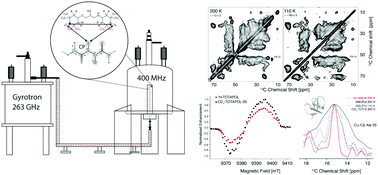Temperature dependence of cross-effect dynamic nuclear polarization in rotating solids: advantages of elevated temperatures†
Abstract
Dynamic nuclear polarization exploits electron spin polarization to boost signal-to-noise in magic-angle-spinning (MAS) NMR, creating new opportunities in materials science, structural biology, and metabolomics studies. Since protein NMR spectra recorded under DNP conditions can show improved spectral resolution at 180–200 K compared to 110 K, we investigate the effects of AMUPol and various deuterated TOTAPOL isotopologues on sensitivity and spectral resolution at these temperatures, using proline and reproducibly prepared SH3 domain samples. The TOTAPOL deuteration pattern is optimized for protein DNP MAS NMR, and signal-to-noise per unit time measurements demonstrate the high value of TOTAPOL isotopologues for Protein DNP MAS NMR at 180–200 K. The combined effects of enhancement, depolarization, and proton longitudinal relaxation are surprisingly sample-specific. At 200 K, DNP on SH3 domain standard samples yields a 15-fold increase in signal-to-noise over a sample without radicals. 2D and 3D NCACX/NCOCX spectra were recorded at 200 K within 1 and 13 hours, respectively. Decreasing enhancements with increasing 2H-content at the CH2 sites of the TEMPO rings in CD3-TOTAPOL highlight the importance of protons in a sphere of 4–6 Å around the nitroxyl group, presumably for polarization pickup from electron spins.



 Please wait while we load your content...
Please wait while we load your content...